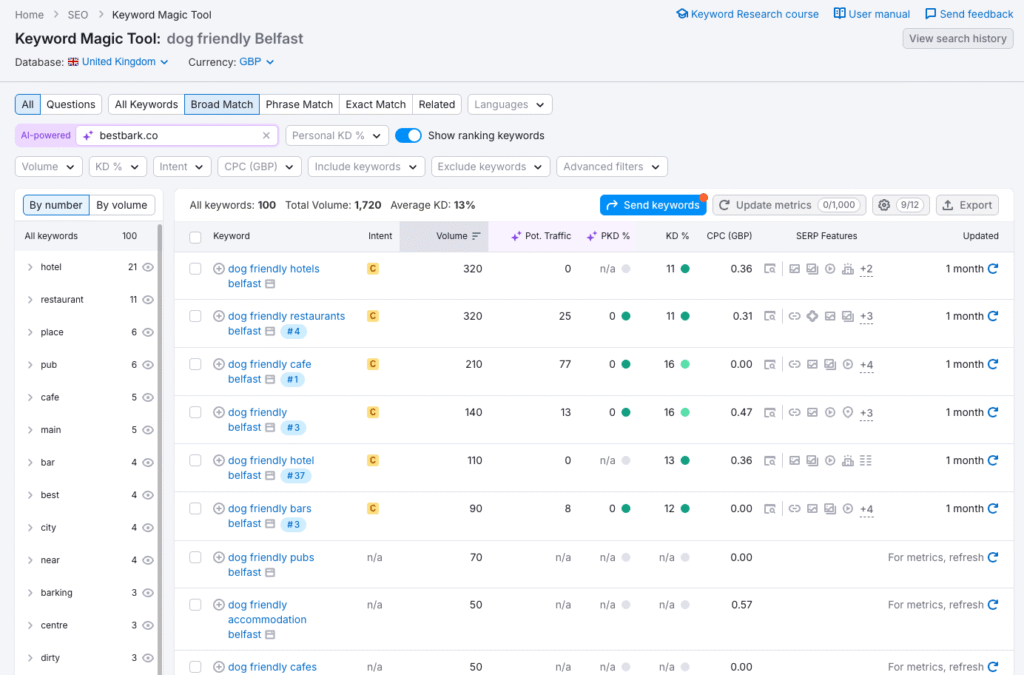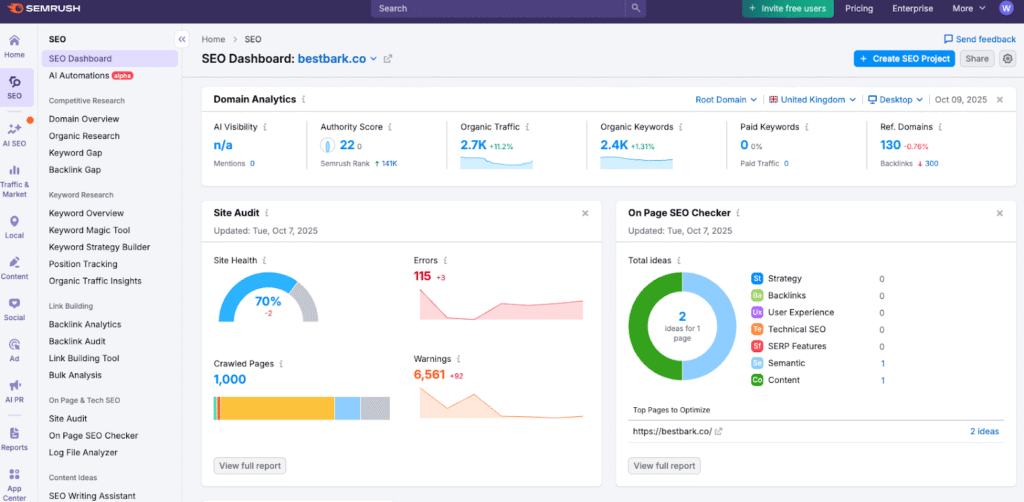At GEKKOSHOT, every website we design and every marketing strategy we deliver begins with one principle data before design. Beautiful websites mean very little if they’re not found online. That’s why Semrush sits at the heart of our SEO and digital marketing toolkit.
We use it not just to audit websites, but to understand markets, measure competitors, and uncover opportunities our clients can own. Here’s a look at how we use Semrush in real campaigns, what data matters most, and why it’s a critical part of our strategy process.
Why We Use Semrush
Semrush gives us one platform for research, reporting, and competitive insight. For agencies like ours that manage multiple brands across different industries from hospitality and eCommerce to construction and healthcare it allows us to streamline SEO, PPC, and content planning in one space.
Where it really shines is in its clarity of data. We can see exactly what’s working, what isn’t, and where we can create quick wins.
Some of the key features we rely on include:
- Site Audit – Identifies technical SEO issues before they become ranking problems.
- Keyword Magic Tool – Helps us find profitable search terms that balance traffic volume with realistic competition.
- Position Tracking – Monitors ranking changes daily, allowing us to measure campaign impact.
- Backlink Analytics – Reveals which sites link to our clients’ competitors and which ones we should build relationships with.
- Content Gap Analysis – Compares top-performing content in our clients’ niches to pinpoint what’s missing.
Step 1: SEO Audits That Go Beyond Surface-Level Checks
Before any web project begins, our team runs a Semrush Site Audit on the client’s existing domain. It checks over 140 factors including crawlability, meta data, HTTPS status, and internal linking.
This initial audit forms the technical foundation of every strategy. It allows our developers and content specialists to see what’s slowing the site down and what Google’s crawlers might be missing.
We then use this data to build a technical checklist often implemented during a redesign or rebuild ensuring that when the new site launches, it’s not just visually appealing, but structurally optimised for search.
Step 2: Building Content Strategies from Keyword Data
Once the technical side is clear, we move into keyword research and topic planning using Semrush’s Keyword Magic Tool.
Our focus isn’t simply on chasing the highest-volume terms. Instead, we look for intent-based keywords the real questions and searches potential customers use when they’re close to taking action.
For example:
- A generic keyword might be “dog friendly Belfast..”
- A higher-converting intent keyword might be “dog friendly cafes Belfast city centre.”
That subtle difference can transform campaign results.

By grouping keywords into content clusters, we create a roadmap that guides website structure, blog topics, and landing pages. Each cluster targets a core theme supported by related long-tail terms, helping our clients build topical authority and long-term search visibility.
Step 3: Competitor Benchmarking and Gap Analysis
One of the most valuable features in Semrush is Domain vs. Domain comparison. This lets us directly compare a client’s site with their competitors to see:
- Which keywords they rank for (and we don’t)
- How their traffic is distributed
- Which backlinks drive the most authority
We often find that competitors are ranking for low-difficulty, high-intent terms that the client has never targeted a fast and efficient growth opportunity.
This competitive insight shapes our on-page optimisation, PPC bidding, and link-building strategy. It’s not guesswork. It’s data-led marketing that delivers measurable ROI.
Step 4: Tracking Performance and Reporting Transparently
One of the reasons our clients stay with GEKKOSHOT long term is transparency. They see exactly what we see and that’s powered by Semrush’s Position Tracking and My Reports tools.
We create live dashboards that track:
- Keyword ranking changes
- Traffic growth over time
- Visibility trends by location
- Featured snippet and People Also Ask appearances
Clients receive monthly reports summarising movement, wins, and next steps. Because Semrush integrates with Google Analytics and Search Console, we can consolidate all performance data in one report.
Real Example: A Local Business Going National
A recent client, a Northern Ireland-based service provider, came to us with strong local visibility but limited reach beyond Belfast.
Using Semrush, we identified the top 10 competitors dominating UK-wide searches for the same services. From there, we:
- Analysed their backlink profiles to find common referring domains
- Mapped keyword clusters by region (e.g. “construction company Northern Ireland,” “building contractors Belfast,” “commercial builders Northern Ireland”)
- Built a 6-month content plan targeting those clusters
- Launched a regional PPC campaign with keyword match types aligned to Semrush volume data
Within four months, their visibility score increased by 78%, and traffic from outside Northern Ireland grew by over 200%.
It’s a perfect example of how Semrush supports both strategic thinking and tactical execution.
Step 5: Enhancing Collaboration Across Teams
As a multidisciplinary agency, GEKKOSHOT blends design, content, development, and marketing. Semrush acts as the shared platform where these disciplines meet.
- The design team uses audit insights to optimise user experience and site structure.
- Our Writers use keyword research and content gap analysis to create blog posts and landing pages that rank.
- Developers resolve technical issues identified in crawl reports.
- Account managers use My Reports for client updates and campaign reviews.
This cross-department visibility ensures every website launch and campaign is driven by data and aligned with long-term performance goals.
Thought Leadership: Why Data Tools Don’t Replace Expertise
There’s a misconception that tools like Semrush can do the work for you. The truth is, they provide the map but you still need an expert to interpret it.
At GEKKOSHOT, we don’t just look at keyword volume or difficulty scores in isolation. We interpret what those numbers mean in the real world.
For example, a keyword might show low difficulty, but if the intent doesn’t align with the client’s audience, it’s a distraction. Or, a high-difficulty keyword might be worth the investment if it’s part of a larger content strategy that builds brand authority over time.
Data informs decisions, it doesn’t make them. That’s where our human insight, creative thinking, and years of digital experience come in.
How We Present Semrush Insights to Clients
We believe good data should be understood, not hidden in spreadsheets.
That’s why our Semrush reports are visual, concise, and tailored to each client. We highlight wins, explain what changed, and show where we’re focusing next. Every client knows exactly how their website is performing and what actions we’re taking to improve it.

Let’s Build Your Next Digital Strategy
Semrush is more than a reporting tool for us, it’s the foundation of how we plan, execute, and refine digital strategies.
Whether we’re redesigning a website, planning an SEO campaign, or advising on PPC budgets, Semrush helps GEKKOSHOT deliver data-driven clarity and measurable growth for every client.
If you’d like to see how your business could benefit from a data-led digital strategy, get in touch with our team. We’ll review your current online presence and provide a free, no-obligation quote tailored to your goals.


